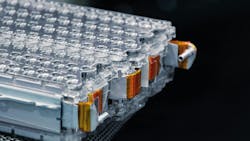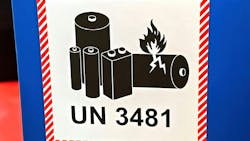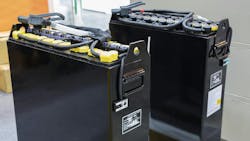Second-Life Batteries Offer Benefits, but Market Challenges Remain
The push for electrification in a range of industries is driving unprecedented growth for lithium-ion battery production. With this also comes the need to determine what to do with these batteries once past their useful life.
Repurposing them for other applications, referred to as second-life batteries, is one of the options available in the market. This provides a purpose for batteries that may otherwise have gone unused due to surplus production or cancelled projects as well as those that may still have power left in them but just not enough to meet the requirements of the original application in which they were used.
Why this matters
Electrification has become an important design factor for the machine and vehicle applications served by hydraulic, pneumatic and electric motion control solutions. Pairing them with battery systems is often required to ensure optimized performance. Therefore, having an understanding of the various facets of the battery market and options available can benefit the design process.
By repurposing batteries, their lifespan can be extended which helps to keep them from entering landfills or recycling facilities sooner than necessary. It can also reduce the need to produce as many new batteries, helping to lower emissions and materials use.
But despite the benefits offered by second-life batteries, the market for them remains underdeveloped in many global regions including the U.S. In this article, author Maxim Khabur, Marketing Director at Bluewater — a battery lifecycle management company — outlines some of the current challenges facing the second-life battery market and what is needed to overcome them.
Top 3 Issues Facing the Second-Life Battery Market
While giving batteries a second life offers many benefits, today a large portion of retired lithium-ion batteries are sent directly recycling facilities. These batteries may still be new, never cycled or still have a state of health exceeding 80% — enabling them to be used in a number of applications.
Although cheaper to purchase than a new battery, there are some hurdles the second-life battery market needs to overcome.
1. A Lack of Testing and Certification Standards
A lot of work goes into repurposing lithium-ion batteries to ensure they will safely perform as desired. Rigorous testing is required, which can be costly and time consuming. In some regions, there is also a lack of standardization for testing and grading batteries. This adds complexity for both buyers and sellers of second-life batteries.
Many companies in Asia and Europe have developed the expertise needed to handle large volumes of retired batteries of various chemistries and form factors. A digital passport is included with batteries in these regions, and will be required in the European Union starting in 2025, which helps to simplify testing and reduce associated costs.
In the U.S., these standards and testing capabilities do not exist. The impetus for this testing is also typically placed on the first-life battery owners, many of whom do not have the equipment or resources to test batteries. As such, this can slow down or completely negate their ability to sell their batteries for reuse.
2. Logistics Requirements
Another challenge is the special shipping and handling required for batteries. There are often regulations that must be followed for classification, packaging, labeling and documentation.
This is necessary to ensure the safe transport of batteries, but can add costs and complexity for those trying to sell second-life batteries who may not have the logistics expertise required.
Domestic and international shipping costs can be high. A cross-country truck shipment can cost as much as $5,000–6,000. And when shipping internationally, expensive UN-certified packaging is often required.
3. Declining New Battery Costs
The prices for new lithium-ion batteries have decreased in recent years as technology has advanced and more capacity has been added to the market. As such, it is harder for second-life batteries to compete in the marketplace.
With cost not being as much of a factor, many purchasers may instead choose a new battery because of the warranties it includes as well as being equipped with the latest technologies.
For those selling their batteries for second-life use, contracts can take time to finalize and there may be a disconnect between seller and buyer in terms of cost expectations, adding further challenges to the market, particularly in the U.S.
Some first-life battery owners expect to recoup 50% or more of the original value of their batteries whereas a second-life battery purchaser would prefer to pay 10-20% of the original price.
In Asia and Europe, infrastructure and financing for second-life batteries are more developed which helps to make it a more established and viable market in those regions.
Steps to Improve Second-Life Battery Uptake
Although the second-life battery market has several challenges to overcome, there are many benefits that can be realized in doing so.
Extending a battery’s lifespan helps to reduce waste and resources which can help meet global efforts to improve sustainability. Although there are costs associated with second-life batteries, they still offer an affordable option for many applications such as battery energy storage systems (BESS) used in solar and wind farms.
To help improve the market potential for second-life batteries, there are three key steps that should be taken:
- Standardize testing and grading processes. This will help reduce the amount of labor currently associated with repurposing lithium-ion batteries, leading to improved efficiencies and prices.
- Design for second life. By considering a battery’s ability to be reused from the initial development stage, it could be designed to allow for easier disassembly to help reduce labor and costs. Including accessible and reliable data on each battery, such as through a battery passport, would also help to reduce the time and costs associated with repurposing batteries for a second life.
- Raise awareness about second-life batteries. Informing the market about the potential environmental and financial benefits of second-life batteries, for both sellers and purchasers, as well as demystifying some of the risks could help to improve perceptions and uptake.
Collective action from stakeholders across the battery industry will be required to overcome the challenges currently facing the second-life battery market. But by doing so, it will also be possible to realize a variety of benefits including cost and waste reductions.
This article was written and contributed by Maxim Khabur, Marketing Director at Bluewater.
About the Author

Maxim Khabur
Director of Marketing, Bluewater
Maxim Khabur is director of marketing at Bluewater, a battery lifecycle management company. He also serves as chairman of the Advanced Energy Council which represents a group of 20-plus companies working in the area of advanced energy technologies who are also members of MHI.org (Materials Handling Industry Association).

Leaders relevant to this article:



